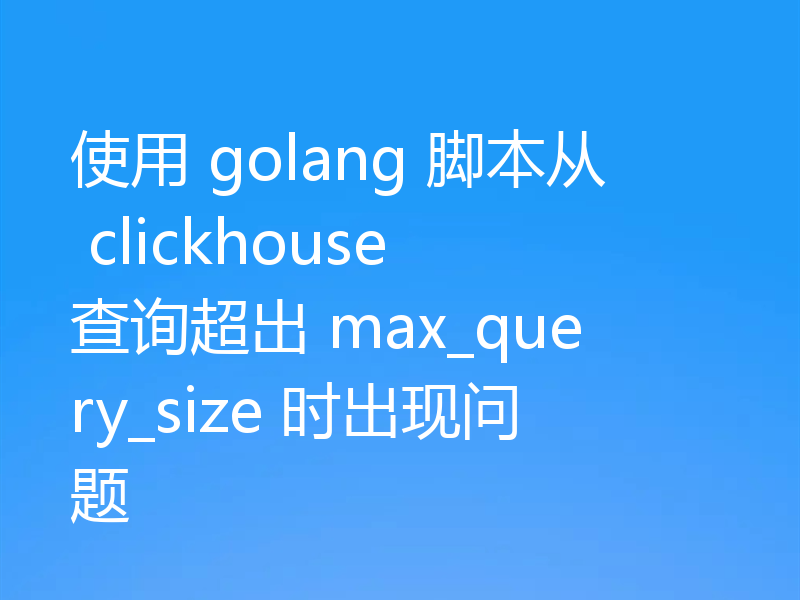在go中设置二叉树的索引
来源:stackoverflow
2024-02-12 16:21:15
0浏览
收藏
从现在开始,我们要努力学习啦!今天我给大家带来《在go中设置二叉树的索引》,感兴趣的朋友请继续看下去吧!下文中的内容我们主要会涉及到等等知识点,如果在阅读本文过程中有遇到不清楚的地方,欢迎留言呀!我们一起讨论,一起学习!
问题内容
我正在尝试自学数据结构和算法,并且正在尝试找出向二叉树添加索引的最佳方法
我猜最好的方法是修改 in ordertraversal 操作,但我不确定如何实现它并在每个插入和删除函数之后链接它。
type BinarySearchNode struct {
Left *BinarySearchNode
Right *BinarySearchNode
Parent *BinarySearchNode
Data int
Index int
}
func (BSN *BinarySearchNode) Insert(value int){
if BSN.Data > value {
if BSN.Left == nil{
BSN.Left = &BinarySearchNode{Data:value, Parent:BSN}
return
}
BSN.Left.Insert(value)
return
}
if BSN.Right == nil{
BSN.Right = &BinarySearchNode{Data:value, Parent: BSN}
return
}
BSN.Right.Insert(value)
}
func (BSN *BinarySearchNode) setIndex(node *BinarySearchNode, count int)(int){
if node == nil{
return count
}
if node.Right == nil && node.Left == nil{
node.Index = count
}
node.setIndex(node.Left, count+1)
node.setIndex(node.Right, count+1)
return count
}正确答案
我有一段在golang中实现二叉树的代码。它可能对你有帮助。
package main
import (
"fmt"
"math"
)
// A single Node in a binary tree
type Node struct {
// Value contained by the node
Value int
// Left subnode of the node
Left *Node
// Right subnode of the node
Right *Node
}
type BinaryTree struct {
Root *Node
}
// inserting the element in the binary tree
func (tree *BinaryTree) Insert(value int) {
if tree.Root == nil {
node := new(Node)
node.Value = value
tree.Root = node
return
}
current := tree.Root
for {
if value < current.Value {
if current.Left == nil {
node := new(Node)
node.Value = value
current.Left = node
return
} else {
current = current.Left
}
} else {
if current.Right == nil {
node := new(Node)
node.Value = value
current.Right = node
return
} else {
current = current.Right
}
}
}
}
// current left right
func (tree *BinaryTree) RecursivePreOrder(root *Node) {
if root == nil {
return
}
fmt.Println(root.Value)
tree.RecursivePreOrder(root.Left)
tree.RecursivePreOrder(root.Right)
}
func (tree *BinaryTree) IterativePreOrder(root *Node) {
stack := []*Node{}
for {
for root != nil {
fmt.Println(root.Value)
stack = append([]*Node{root}, stack...)
root = root.Left
}
if len(stack) == 0 {
break
}
root = stack[0]
stack = stack[1:]
root = root.Right
}
}
func (tree *BinaryTree) RecursiveInOrder(root *Node) {
if root == nil {
return
}
tree.RecursiveInOrder(root.Left)
fmt.Println(root.Value)
tree.RecursiveInOrder(root.Right)
}
func (tree *BinaryTree) IterativeInOrder(root *Node) {
var stack []*Node
for {
for root != nil {
stack = append([]*Node{root}, stack...)
root = root.Left
}
if len(stack) == 0 {
break
}
root = stack[0]
stack = stack[1:]
fmt.Println(root.Value)
root = root.Right
}
}
func (tree *BinaryTree) RecursivePostOrder(root *Node) {
if root == nil {
return
}
tree.RecursivePostOrder(root.Left)
tree.RecursivePostOrder(root.Right)
fmt.Println(root.Value)
}
func (tree *BinaryTree) IterativePostOrder(root *Node) {
stack := []*Node{}
var previous *Node = nil
for {
for root != nil {
stack = append([]*Node{root}, stack...)
root = root.Left
}
for root == nil && len(stack) != 0 {
root = stack[0]
if root.Right == nil || root.Right == previous {
fmt.Println(root.Value)
stack = stack[1:]
previous = root
root = nil
} else {
root = root.Right
}
}
if len(stack) == 0 {
break
}
}
}
func (tree *BinaryTree) LevelOrder(root *Node) {
// a queue for performing level order traversal of breadth first traversal
queue := []*Node{}
if root != nil {
queue = append(queue, root)
}
for len(queue) > 0 {
root = queue[0]
queue = queue[1:]
fmt.Println(root.Value)
if root.Left != nil {
queue = append(queue, root.Left)
}
if root.Right != nil {
queue = append(queue, root.Right)
}
}
}
func (tree *BinaryTree) Size(root *Node) int {
if root == nil {
return 0
}
sum := tree.Size(root.Left) + 1 + tree.Size(root.Right)
return sum
}
func (tree *BinaryTree) ElementAt(root *Node, index int) *Node {
if index > tree.Size(root)-1 {
fmt.Println("Index doesnot exist")
return nil
}
leftSize := tree.Size(root.Left)
if index == leftSize {
return root
} else if index < leftSize {
return tree.ElementAt(root.Left, index)
} else {
return tree.ElementAt(root.Right, index-leftSize-1)
}
}
func (tree *BinaryTree) Height(root *Node) int {
if root == nil {
return -1
}
return int(math.Max(float64(tree.Height(root.Left)), float64(tree.Height(root.Right)))) + 1
}
// starting point of the program
func main() {
tree := new(BinaryTree)
tree.Insert(44)
tree.Insert(55)
tree.Insert(33)
fmt.Println(tree.Height(tree.Root))
}到这里,我们也就讲完了《在go中设置二叉树的索引》的内容了。个人认为,基础知识的学习和巩固,是为了更好的将其运用到项目中,欢迎关注golang学习网公众号,带你了解更多关于的知识点!
版本声明
本文转载于:stackoverflow 如有侵犯,请联系study_golang@163.com删除
 我需要做什么来执行具有如下所示的“命名”导入的示例 golang 代码?
我需要做什么来执行具有如下所示的“命名”导入的示例 golang 代码?
- 上一篇
- 我需要做什么来执行具有如下所示的“命名”导入的示例 golang 代码?

- 下一篇
- 使用 golang 脚本从 clickhouse 查询超出 max_query_size 时出现问题
查看更多
最新文章
-

- Golang · Go问答 | 1年前 |
- 在读取缓冲通道中的内容之前退出
- 139浏览 收藏
-

- Golang · Go问答 | 1年前 |
- 戈兰岛的全球 GOPRIVATE 设置
- 204浏览 收藏
-

- Golang · Go问答 | 1年前 |
- 如何将结构作为参数传递给 xml-rpc
- 325浏览 收藏
-

- Golang · Go问答 | 1年前 |
- 如何用golang获得小数点以下两位长度?
- 478浏览 收藏
-

- Golang · Go问答 | 1年前 |
- 如何通过 client-go 和 golang 检索 Kubernetes 指标
- 486浏览 收藏
-

- Golang · Go问答 | 1年前 |
- 将多个“参数”映射到单个可变参数的习惯用法
- 439浏览 收藏
-

- Golang · Go问答 | 1年前 |
- 将 HTTP 响应正文写入文件后出现 EOF 错误
- 357浏览 收藏
-

- Golang · Go问答 | 1年前 |
- 结构中映射的匿名列表的“复合文字中缺少类型”
- 352浏览 收藏
-

- Golang · Go问答 | 1年前 |
- NATS Jetstream 的性能
- 101浏览 收藏
-

- Golang · Go问答 | 1年前 |
- 如何将复杂的字符串输入转换为mapstring?
- 440浏览 收藏
-

- Golang · Go问答 | 1年前 |
- 相当于GoLang中Java将Object作为方法参数传递
- 212浏览 收藏
-

- Golang · Go问答 | 1年前 |
- 如何确保所有 goroutine 在没有 time.Sleep 的情况下终止?
- 143浏览 收藏
查看更多
课程推荐
-

- 前端进阶之JavaScript设计模式
- 设计模式是开发人员在软件开发过程中面临一般问题时的解决方案,代表了最佳的实践。本课程的主打内容包括JS常见设计模式以及具体应用场景,打造一站式知识长龙服务,适合有JS基础的同学学习。
- 542次学习
-

- GO语言核心编程课程
- 本课程采用真实案例,全面具体可落地,从理论到实践,一步一步将GO核心编程技术、编程思想、底层实现融会贯通,使学习者贴近时代脉搏,做IT互联网时代的弄潮儿。
- 511次学习
-

- 简单聊聊mysql8与网络通信
- 如有问题加微信:Le-studyg;在课程中,我们将首先介绍MySQL8的新特性,包括性能优化、安全增强、新数据类型等,帮助学生快速熟悉MySQL8的最新功能。接着,我们将深入解析MySQL的网络通信机制,包括协议、连接管理、数据传输等,让
- 498次学习
-

- JavaScript正则表达式基础与实战
- 在任何一门编程语言中,正则表达式,都是一项重要的知识,它提供了高效的字符串匹配与捕获机制,可以极大的简化程序设计。
- 487次学习
-

- 从零制作响应式网站—Grid布局
- 本系列教程将展示从零制作一个假想的网络科技公司官网,分为导航,轮播,关于我们,成功案例,服务流程,团队介绍,数据部分,公司动态,底部信息等内容区块。网站整体采用CSSGrid布局,支持响应式,有流畅过渡和展现动画。
- 484次学习
查看更多
AI推荐
-

- 千音漫语
- 千音漫语,北京熠声科技倾力打造的智能声音创作助手,提供AI配音、音视频翻译、语音识别、声音克隆等强大功能,助力有声书制作、视频创作、教育培训等领域,官网:https://qianyin123.com
- 125次使用
-

- MiniWork
- MiniWork是一款智能高效的AI工具平台,专为提升工作与学习效率而设计。整合文本处理、图像生成、营销策划及运营管理等多元AI工具,提供精准智能解决方案,让复杂工作简单高效。
- 122次使用
-
- NoCode
- NoCode (nocode.cn)是领先的无代码开发平台,通过拖放、AI对话等简单操作,助您快速创建各类应用、网站与管理系统。无需编程知识,轻松实现个人生活、商业经营、企业管理多场景需求,大幅降低开发门槛,高效低成本。
- 136次使用
-

- 达医智影
- 达医智影,阿里巴巴达摩院医疗AI创新力作。全球率先利用平扫CT实现“一扫多筛”,仅一次CT扫描即可高效识别多种癌症、急症及慢病,为疾病早期发现提供智能、精准的AI影像早筛解决方案。
- 131次使用
-
- 智慧芽Eureka
- 智慧芽Eureka,专为技术创新打造的AI Agent平台。深度理解专利、研发、生物医药、材料、科创等复杂场景,通过专家级AI Agent精准执行任务,智能化工作流解放70%生产力,让您专注核心创新。
- 132次使用
查看更多
相关文章
-
- GoLand调式动态执行代码
- 2023-01-13 502浏览
-
- 用Nginx反向代理部署go写的网站。
- 2023-01-17 502浏览
-
- Golang取得代码运行时间的问题
- 2023-02-24 501浏览
-
- 请问 go 代码如何实现在代码改动后不需要Ctrl+c,然后重新 go run *.go 文件?
- 2023-01-08 501浏览
-
- 如何从同一个 io.Reader 读取多次
- 2023-04-11 501浏览



